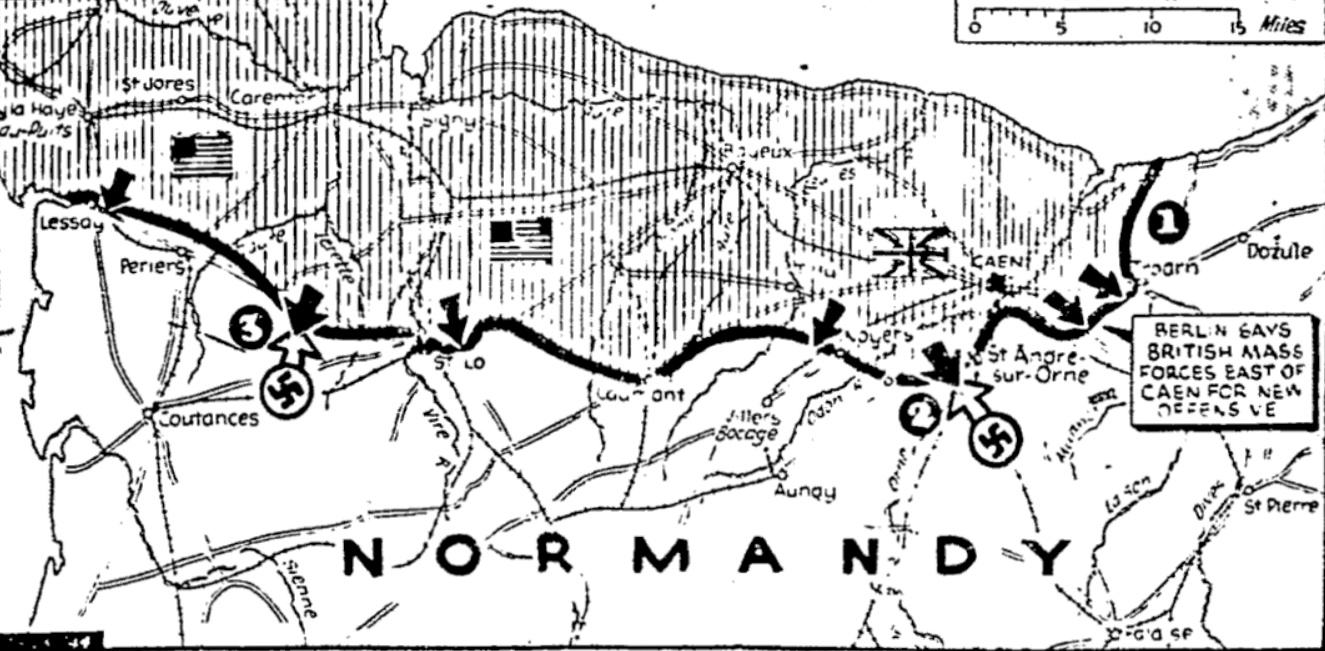On the Normandy front –
Casey: ‘Forgotten soldiers’ keep war machine in motion
Unrecognized, engineers and Signal Corps fight battle of communications and supply
By Robert J. Casey
U.S. front in Normandy, France – (July 19, delayed)
You don’t have to look at this war very long to realize that the most important part of it, aside from the riflemen in the frontlines, is to be found in the roads behind. Actually, it is here that you get some cohesive idea of the purpose and extent of the Allied drive.
Impressions of a battle, where it is fought behind dikes and hedges, necessarily must be isolated – a tank working here, infantry crawling through an orchard against machine guns there. But in the backroads and sunken lanes, you can see the war, terrible in its power, rolling forward with all the strange gadgets and accoutrements with which modern military science has equipped it.
No one who has not been tangled in it can envision the traffic on these channels from the beaches to the front. The principal routes are still good auto roads, or had been until D-Day changed the face of Normandy. Now, literally thousands of trucks, jeeps, tanks, halftracks, command cars, tractors, bulldozers, self-propelled artillery, motorcycles, mobile derricks and tank carriers pour over them 24 hours a day.
Pavements holding up
The pavements are holding up better than you would think. If any of them could be closed, a mile or two at a time for a few hours, the road crews that did the miraculous job of constructing airplane runways in England could lay new broad pavements over the old at an astonishing rate. But they can’t be closed and engineers work in disheartening competition with traffic.
Nobody thinks much about these forgotten men of the war, these pick-and-shovel soldiers, but as you follow the highway over newly-built bridges and past blasted villages and watch it widening and straightening before your eyes, you wonder how this battle, dependent as it is on mechanized material, could have been fought without them.
Wars in civilized communities seem to leave roads with typical scars, most of them on telephone and transmission lines. You’d naturally think wires strung on poles well away from the blasts on the pavement would suffer little damage from artillery or mines, but from every pole, festoons of broken wire hang like jungle growth. Flying fragments have found these impossible targets, cut the cables and shattered the insulators.
Other forgotten soldiers
So along with the engineers march other forgotten soldiers, the never-sleeping men of the Signal Corps. Along even the most remote lanes you are constantly passing signal trucks from which new wire is being reeled out in staggering quantities, thousands of miles of it.
You run into these men under shellfire at artillery observation posts and advance CPs enmeshed in communication webs that seem always a hopeless tangle, lifting wire out of ditches onto tree branches, hunting for breaks, making spices with no apparent concern for the death whistling over them or exploding around them.
The highways of the beachhead are marked with signs put there before the war by French touring clubs or local departments, more legible German markers and directions to American units, in a variety of colors and a jargon of codenames.
MPs on the job
Despite all this, a messenger might still have to go home with his important communication were it not for the MPs, who stand at every crossroads in the entire area. They are a remarkable set of men, these. Most of them never saw France until D-Day, but they can tell you which is the shortest road to any town you may name, where you make your turnings, which roads are well-paved, which under shellfire, and they have memorized more unit codenames and locations than you would find in a transatlantic cable book.
This is remarkable enough in itself. When you consider that command posts and dressing stations and such are constantly moving, it is something close to miraculous.
Civilians mingle oddly with the traffic along the roads and caravans of war give them priority. After all, whose country is it? Their carts and cattle mingle with artillery columns and families in horse-drawn buggies ride along with halftracks and tanks. Church processions and funerals go on as if there were no constant avalanche of transport on the throbbing pavements. As far forward as artillery echelons it is no uncommon thing to see them in silent ranks with front-bound doughboys.
Flags welcome liberators
War hasn’t displaced these people. It has merely infiltrated through them and the strangely incongruous lives of military and peasantry go their independent ways side by aide but never touching.
Since long before Bastille Day, flags have been flying from houses along the battle routes – French, American, English – most of them homemade and all of them odd to look upon. Over some doors in towns are banners bearing strange devices “Hail Roosevelt and de Gaulle,” “Death to the Boche,” “Welcome Americans our Liberators.” And, of course, there are always the inevitable children at every doorstep, waving two uplifted fingers at the soiled G.I.’s.
